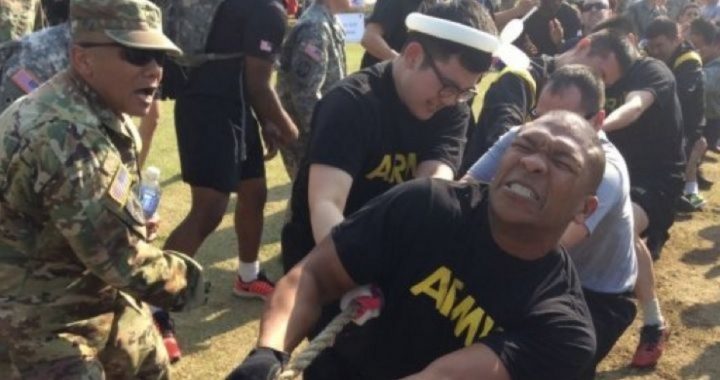
In his farewell address at West Point in 1962, General Douglas MacArthur told the cadets that they would hold the nation’s destiny in their hands “the moment the war tocsin sounds.” The purpose of the armed forces of the United States was clear to that famed warrior: to defend the nation in time of war.
But now the United States is having trouble getting soldiers to reenlist, so the Army is resorting to offering bonuses of up to $90,000 to entice them to continue in military service. The total bonuses will cost the taxpayers more than $380 million.
President Trump’s proposed FY 2018 budget would increase spending on the Department of Defense by $52 billion over FY 2017 — for a total of $639 billion. This fulfilled a campaign theme of his, in which he decried the decline of numbers of troops to the smallest level since 1940. Trump wants to increase the numbers to 540,000, up from the present 460,000.
Congress began efforts to build up the size of the Army last year, even before Trump was sworn in. Under its plan, the number of active-duty soldiers will increase by 16,000 this coming October. Some smaller increases are planned for the National Guard and the Army Reserve, as well.
Major General Jason Evans, head of Human Resources Command, stated, “The top line message is that the Army is hiring,” but he stressed that the expansion will “focus on quality.” This illustrates that the army’s problem in filling its ranks is not new. In order to fight wars in Iraq (with a peak number of deployed soldiers at 160,000) and Afghanistan (with a peak number of 100,000), the military lowered its standards, actually taking many recruits with criminal or drug-use records. Even that was not enough, and many states saw large numbers of their national guardsmen deployed to the wars in Iraq and Afghanistan. Many patriotic Americans gave their lives in those conflicts.
In addition to using bonuses to build up the military, some have suggested a return to the draft, which ended in 1973.
Which raises a very important question. Why did the U.S. Army have little trouble meeting larger manpower needs during the Cold War, with an all-volunteer force, but now, with a larger population and fewer soldiers needed than then, why can’t the Army fill its ranks?
Beginning just before WWII, and continuing through America’s involvement in Vietnam, the United States relied heavily on the “Selective Service System” — better known as the draft. When America ended its direct military role in South Vietnam in 1973, morale in the armed forces was at a low ebb. Yet, that all changed dramatically in the 1980s during the Reagan administration. Joining the armed forces became much more popular. Although the armed forces grew during that time, with few exceptions (Grenada and the ill-fated deployment of the marines to Lebanon, which Reagan called his greatest mistake while in office), soldiers were not being deployed into war zones.
But after Reagan left office, in the first George Bush presidency, followed by the Clinton years, and finally, the second Bush administration, soldiers began to be deployed repeatedly, as American presidents involved them in multiple military actions overseas, such as in Panama, the Persian Gulf, Haiti, Somalia, Bosnia, Iraq, and Afghanistan.
This repeated interventionism in sovereign nations has had a growing negative effect on morale and enlistments. There was a surge in enlistments after the attacks of September 11, 2001, with a patriotic desire to defend the country from more attacks being a huge motivating factor.
But as American political leaders continue to find even more places to seek military intervention — Libya, Syria, and the like — more and more are questioning what is being accomplished. Almost 4,500 American soldiers have died in Iraq, with almost 2,500 losing their lives in Afghanistan. About one million Americans have been wounded in the two wars. Some have deep emotional scars, as well. And the United States has spent about $6 trillion.
Many contend that the situation in Iraq is actually worse now than before the two American invasions of that country, and with the rise of ISIS, the Middle East in general seems an even greater problem than before this massive expenditure of American blood and treasure.
In addition, progressives have injected their politically correct agenda into the Army, as well as the rest of the armed forces. The U.S. Army has always been an institution affected by the political whims of the day. Contributing greatly to Benedict Arnold’s decision to betray his country was the political decision of Congress not to promote him to major general: His state of Connecticut already had two major generals, while some states had none. Numerous other examples could be cited in American military history, such as the decision in World War II to limit General George Patton’s supplies of gasoline so as to let the Soviet army reach Berlin first.
It has become increasingly clear that the American Army is seen by many liberals as little more than a tool to advance the radical agenda of the American Left. In the second term of President Barack Obama (who set out, in his own words, “to fundamentally transform America”), 400 soldiers in the 67th Signal Battalion at Fort Gordon, Georgia, were even told in a training session, “Our society attaches privilege to being white and male and heterosexual.” Soldiers were informed in a slideshow, “Race privilege gives whites little reason to pay a lot of attention to African Americans.”
The training promoted the concept of “white privilege.”
Can anyone be surprised that some soldiers want out of this mess?
The radicals of the 1960s have taken control of the American Army of the 21st century. While monetary inducements can certainly help in rebuilding the size and morale of the armed forces, the Trump administration should look at ditching these types of things, as well.
Among the assertions foisted upon the soldiers forced to sit through the “training” session were included these: “Our society attaches privilege to being white and male and heterosexual regardless of your social class,” and “Privilege exists when one group has something of value that is denied to others simply because of the groups they belong to, rather than because of anything they’ve done or failed to do.”
Male Army ROTC cadets have even been forced to walk around several college campuses in red high heels to demonstrate that they have a concern about sexual abuse. The Bible, the Constitution, and the Declaration of Independence have even been called sexist documents in an Army training course.
The recent inclusion of women into combat roles has been meekly accepted by the top brass — as if they really had any other choice. Although women average 50-percent less upper body strength than men, and there are real issues with bonding in combat units that include women, political considerations and assertions of equality are considered of greater importance than actually winning wars.
Army Secretary John McHugh, who has since retired, even asserted that women in Army Ranger school performed just as well, and even better, in some cases, than the men. This would imply that no woman performed worse than any of the men, which no one can seriously believe.
McHugh was challenged that the standards were reduced so women could complete the course. When Congressman Steve Russell (R-Okla.), a former Army Ranger, asked for the scores of the women, he was informed that those records no longer existed.
We can guess what great American generals such as MacArthur and Patton would think of all of this, and we can assume that many young Americans have opted out of this madness. Hopefully, the present presidential administration will return to the standard that the purpose of the armed forces is to defend America, “the moment the war tocsin sounds,” and it is not to give lectures on white privilege, make sure women are integrated into combat units, or to send young Americans around the globe on deployments that have little to nothing to do with defending America.
Photo of U.S. Army soldiers: U.S. Army



